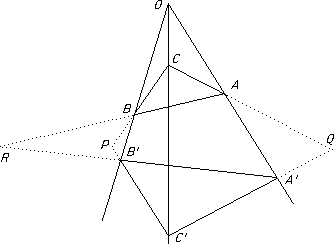 A complete quadrangle ABCD is a set of 4 vertices together with the set of 6 lines joining them.
A complete quadrangle ABCD is a set of 4 vertices together with the set of 6 lines joining them.
These define the three diagonal points PQR.
The cross ratio (A, C ; P , X) = -1
Proof
 Project te points Q and R to points at infinity. This gives the diagram on the right in which abcd is a parallelogram and so ap = pc.
Project te points Q and R to points at infinity. This gives the diagram on the right in which abcd is a parallelogram and so ap = pc.
Thus, since x is at infinity also, (a , c ; p, x) = -1 and the result follows.

Remark
The range (A, Y, D, R) is also harmonic. This gives a method of constructing such harmonic ranges and is the starting point for a variety of geometric constructions.
 (First proved by Girard Desargues (1591 to 1661) In 1639)
(First proved by Girard Desargues (1591 to 1661) In 1639)Two triangles in perspective from a point have corresponding sides meeting in a line.
That is, in the diagram shown in which the lines AA', BB', CC are concurrent in a point P, the meets of AB and A'B', of AC and A'C' and of CB and C'B' are collinear.
Proof
 Project the points P and R to infinity to get the diagram shown.
Project the points P and R to infinity to get the diagram shown.
By similar triangles, ac is parallel to a'c' and so e too is on the line at infinity and so p, q, r are collinear and so too are P, Q, R.

Remarks
- One my also prove this result in 3-dimensional space by observing that the line PQR is the meet of the planes ABC and A'B'C'. The two dimensional case then follows by projection of this 3D figure into a plane.
- This result fails in some projective planes (over finite fields).